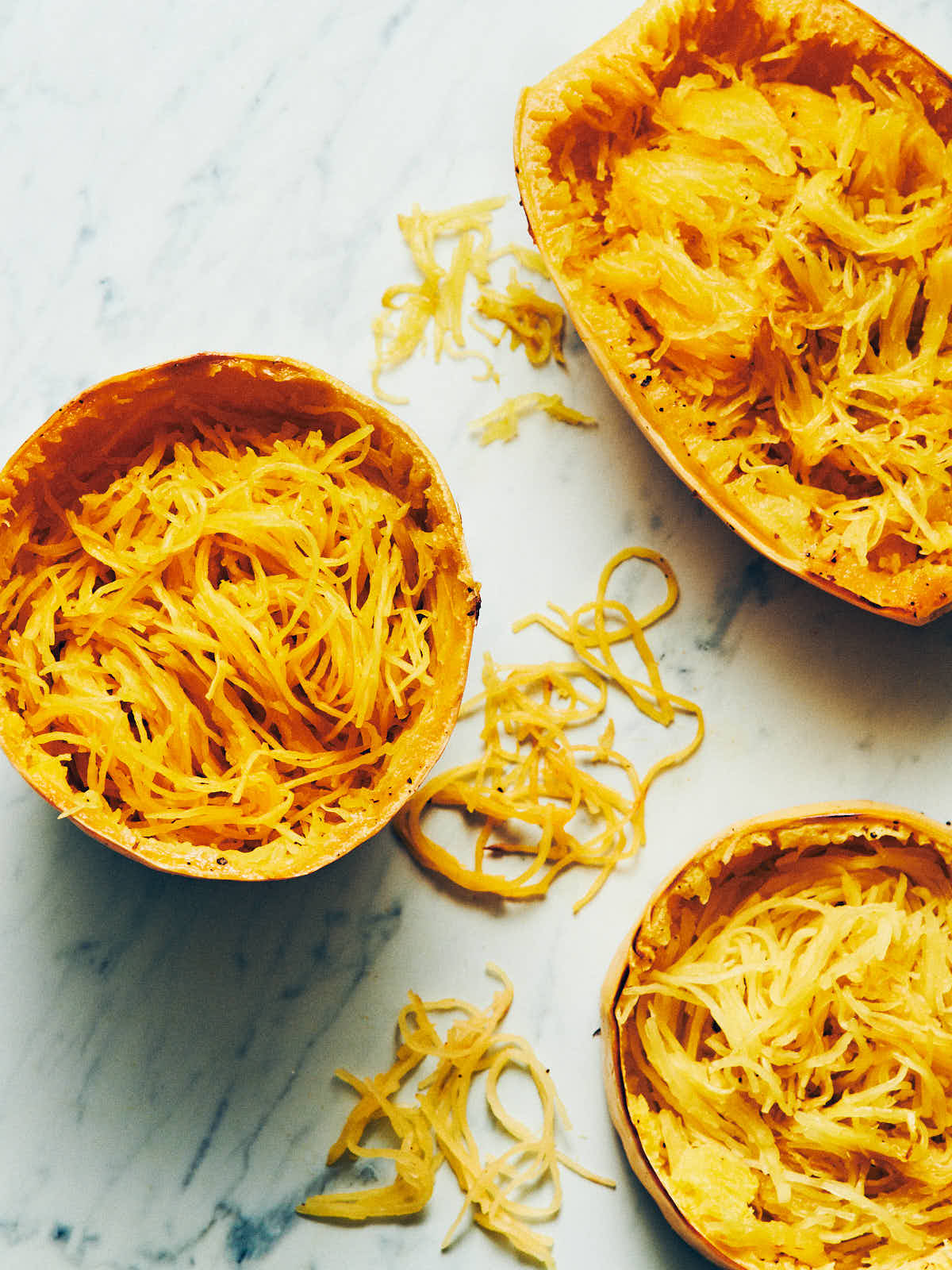
There are many different ways to cook spaghetti squash. But, we wanted to know what is THE BEST method for how to cut and cook spaghetti squash—and thankfully, after lots of testing, we found the answer! In this post, we cover everything you need to know about spaghetti squash. Keep reading to learn about all things spaghetti squash, including the best method for cutting and baking it (with photos)!
Jump to:

What does it taste like?
Spaghetti squash has a very mild, neutral flavor. It tastes ever-so-slightly sweet, but it's so slight, that some would say it barely has any flavor at all! Spaghetti squash definitely tastes better with added seasonings—like salt, pepper, and spices. It also usually gets topped with sauces, cheese, protein, and other garnishes for extra flavor.
One of the biggest appeals of spaghetti squash is that it's a healthy, low calorie vegetable. Its neutral flavor makes it extremely versatile. And once cooked, the insides can be separated into long strands that are often used as a noodle substitute. We even use spaghetti squash noodles in this yummy Spaghetti Squash Pad Thai recipe! For full transparency, we've never been "tricked" into thinking spaghetti squash are real pasta noodles. But, spaghetti squash noodles are definitely a light and healthy way to mix things up!
How to clean it?
You'll want to clean the spaghetti squash before baking it. Much like other winter squashes—like pumpkins, butternut squash, and acorn squash—spaghetti squash has seeds inside of it.
To clean a spaghetti squash, give the outside of the squash a good wash or rinse. Then, once you've cut through the squash, use a spoon to scoop out the seeds and any slimy bits from the inside. You can discard what you've just scooped out—or give the seeds a rinse, season, and bake them in the oven!

Best way to cook it?
There are many ways to cook spaghetti squash including: baking, boiling, microwaving, and steaming. Our favorite way to cook spaghetti squash is baking it. This method avoids adding more water to the squash (which can make your dish watery)—and it also brings out the best flavor. It's also a easy hands-off method!
Below we've tested and photographed the different methods of cutting spaghetti squash and baking it in the oven.
Method 1: Cutting in half lengthwise
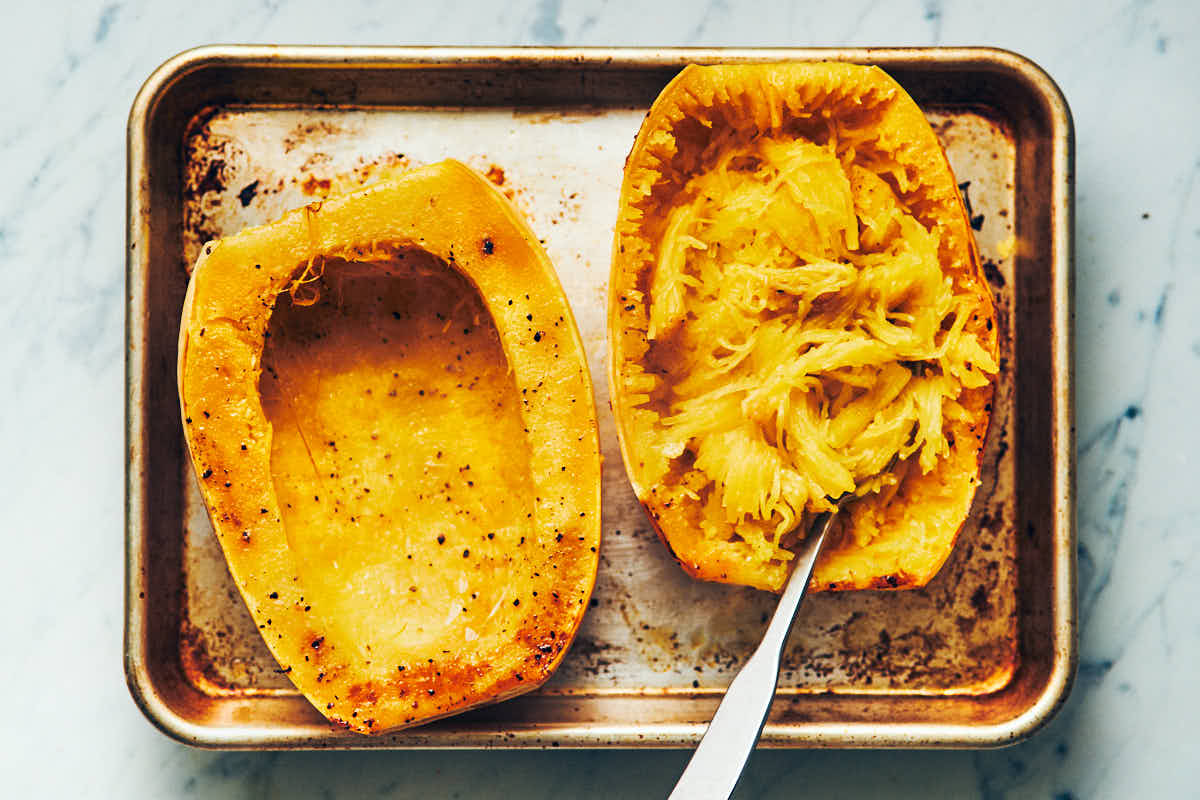
The most common method for cutting a spaghetti squash in half is to slice it lengthwise. The steps for this method are:
- Cut off both ends (top and bottom) of the squash
- Stand the squash upright, on one of the flat cut ends (so that there's a stable base)
- Cut down the length of the squash
- Scoop out the seeds from each half
- Drizzle the cut sides with olive oil and sprinkle with salt and pepper. Arrange the squash cut side down, then bake.
You can watch the step-by-step of the lengthwise method here:
Benefits of cutting spaghetti squash in half lengthwise
- Scooping out the seeds is easy, because you're maximizing the opening and its easy to scrape a spoon against the curved sides.
- You get two spaghetti squash "boats" which are easy to pile high with sauce and toppings.
Disadvantages of cutting spaghetti squash in half lengthwise
- Spaghetti squash is hard (and sometimes scary) to cut. This method involves making 3 cuts, one of which is down the long side of the squash.
- The noodles are short and most likely to break apart when scraping them.

Method 2: Cutting in half crosswise
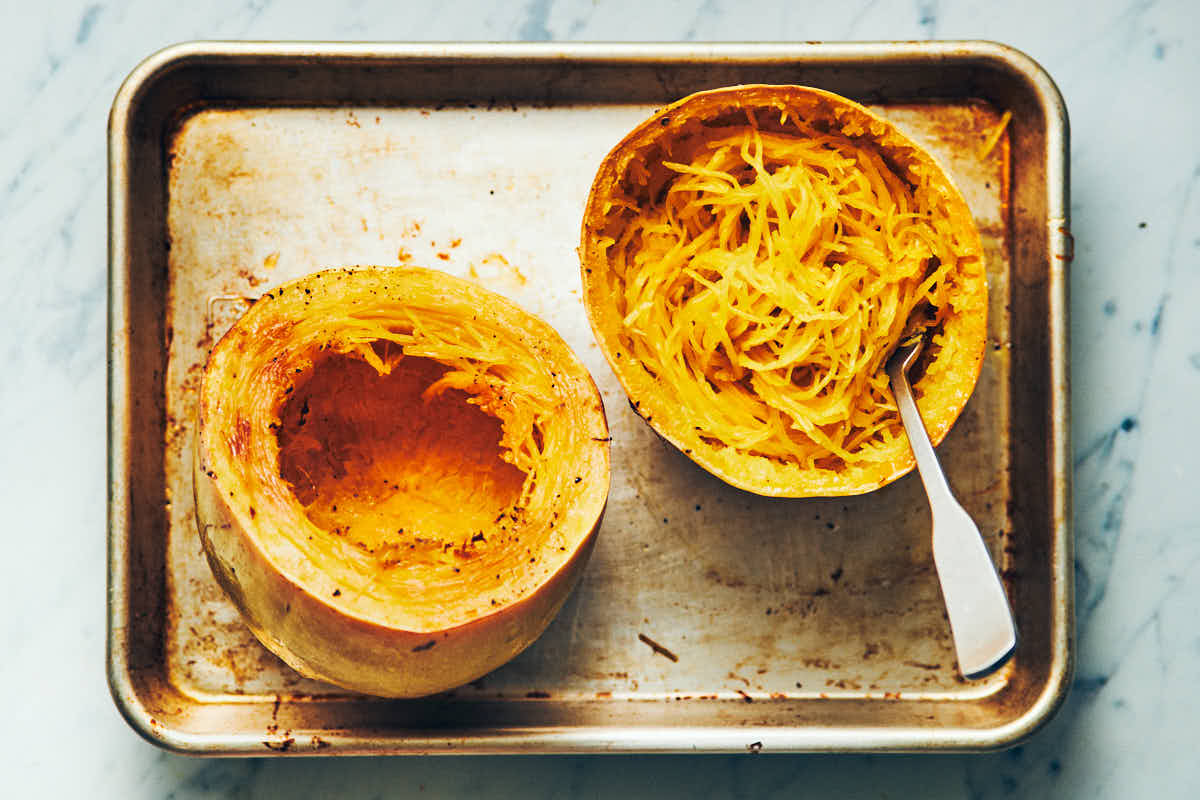
Another way to cut spaghetti squash is to slice it in half crosswise (along the short end). The steps for this method are:
- Cut the squash in half, across the short side
- Scoop out the seeds from each half
- Drizzle the cut ends with oil and sprinkle with a bit of salt and pepper
- Place the cut sides down on a baking sheet, then bake
You can watch the step-by-step of the crosswise method here:
Benefits of cutting spaghetti squash in half crosswise
- There's only one cut to make, because you don't need to cut off the ends
- Spaghetti squash strands run around the width of the squash, not lengthwise, so cutting the squash crosswise yields longer noodles.
Downsides of cutting spaghetti squash in half crosswise
- Not as ideal for spaghetti squash "boats". If we were making a dish that involves piling sauce and cheese over the squash noodles, we'd prefer the lengthwise cut because there's most surface area to nestle all the good stuff (like melted cheese) over.

Method 3: Cutting into rings
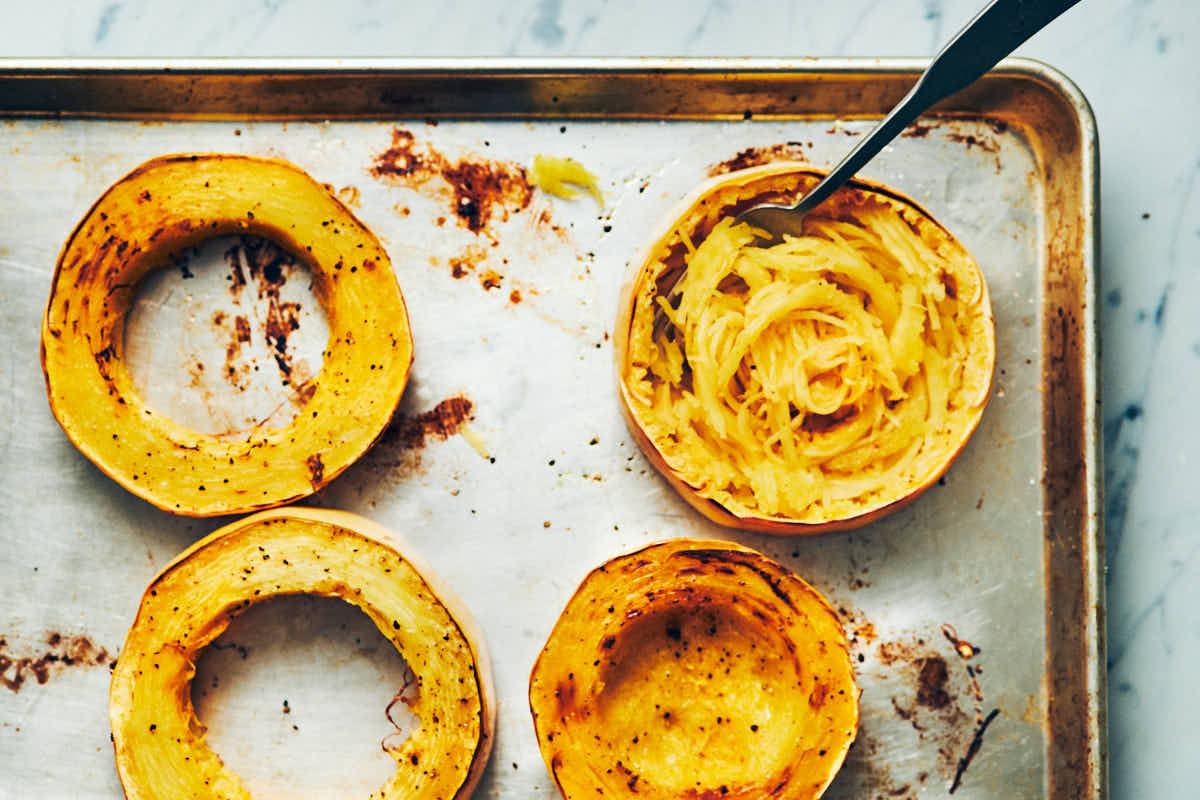
Another method for cutting spaghetti squash is to slice it crosswise into multiple rings. The cuts are made the same direction as method 2, but there are more of them. The steps for this method are:
- Cut off both ends (top and bottom) of the squash
- Cut the squash crosswise into rings (about 1-inch/2.5 cm thick)
- Scoop out the seeds from the middle of each ring
- Drizzle both sides with oil and season with salt and pepper
- Bake, flipping the rings halfway through
You can watch the step-by-step of the rings method here:
Benefits of spaghetti squash into rings
- Similar to method 2, the crosswise cuts here yields longer noodles.
- The rings make it easier to check when the squash is tender (the other methods require you to flip the squash half over to reveal the underside). So, if you're prone to overcooking your spaghetti squash, this could help reduce that risk.
- Increasing the surface area, by having multiple cuts, helps cook off a lot of moisture.
Downsides of cutting spaghetti squash into rings
- This method was the most difficult to cut, because you need to make a lot more cuts into the squash—which frankly, is our least favorite part. Because of this, the prep was the most time consuming.
- We expected the squash to cook faster—and make up for a bit of the extra cutting time—but, the smaller pieces didn't actually cook faster. We think this is because because method 1 and 2 are both cooked cut side down, which helps generate steam inside the squash to help cook it.
- The noodles were drier. While we would prefer this over too wet/mushy, we felt that too much moisture got cooked off. Perhaps using a bit more oil would help compensate, or it could be fine if you're going to end up mixing in other wet ingredients.

Side by side comparison of 3 methods
All three methods of cutting squash—lengthwise, crosswise, and rings—work. But, we do have a clear preference.
Here are the side-by-side results of similarly sized spaghetti squash, baked in the same oven temperature and for the same amount of time.

The biggest differences are:
- The lengthwise cut squash yielded short noodles
- The crosswise cut squash yielded long noodles
- The rings cut squash yielded long noodles, but took more work to prep for the oven

The best method
Our preferred method for cutting and cooking spaghetti squash is to cut it in half crosswise. It is the fastest/easiest to do, requires the fewest cuts (just one!), and yields long noodles that aren't too mushy or too dry. The trick is to make sure you don't overcook them! Be prudent when it comes to checking on the squash in the oven to make sure it doesn't get too soft. If you're mixing the spaghetti squash noodles into a hot sauce, or adding it to ingredients on the stovetop, it's best to be slightly undercooked than overcooked.
Our second favorite method is cutting the squash into rings, because it also makes long noodles. (Once we had long spaghetti squash noodles, it was hard to go back to the short ones!). But in the end, we felt this method was too much work for results that weren't necessarily better than the crosswise cut method.
And lastly, while we don't love the short noodles that come from cutting a spaghetti squash in half lengthwise—this is the method to use if you need spaghetti squash "boats" with a large opening/surface area. For pretty much any purpose, save yourself some effort and cut the spaghetti squash once (crosswise) for long noodles.
See the recipe below for full instructions to cook the perfect spaghetti squash.

Tips for how to easily cut it
Spaghetti squash is very firm, so cutting it isn't always easy. Here are our tips for how to safely and more easily cut it:
- Make sure your cutting board is sturdy and not sliding around (we like to lay a flat kitchen towel between the counter and cutting board to give it more grip!)
- Use a large, sharp chef's knife (a dull knife is dangerous and will make it very difficult to safely cut spaghetti squash)
- Use your other hand to firmly hold the other end of the squash (keep fingers away from the knife, and use a kitchen towel for more grip if you need)
- Cut the spaghetti squash crosswise—it minimizes the cutting required because you just need to do one (no need to trim the ends)
- If you're still having trouble, you can soften the squash in the microwave first before cutting
How to use a microwave to soften squash before cutting
With our recommended method of cutting the squash crosswise, we don't find it necessary to microwave the squash to soften it. Because, you just need to make one cut! But, if you're still struggling to cut spaghetti squash, here's how you can soften it in the microwave:
Poke holes on the outside of the squash—using the tip of a knife or a fork—to allow steam to escape. Microwave for 3 to 5 minutes until the outside of the squash feels slightly softer when pushed with your thumb (at this point you might see a bit of liquid coming out of the holes you made).
You're not aiming to make the squash soft to the touch in the microwave (by that point you'd really have cooked it). All you want to do is get it to the point where it feels like it has a tiny bit of give when you push firmly on the outside skin. Once you cut through the tough outer skin the inside of the squash will be softer and easier to cut through.
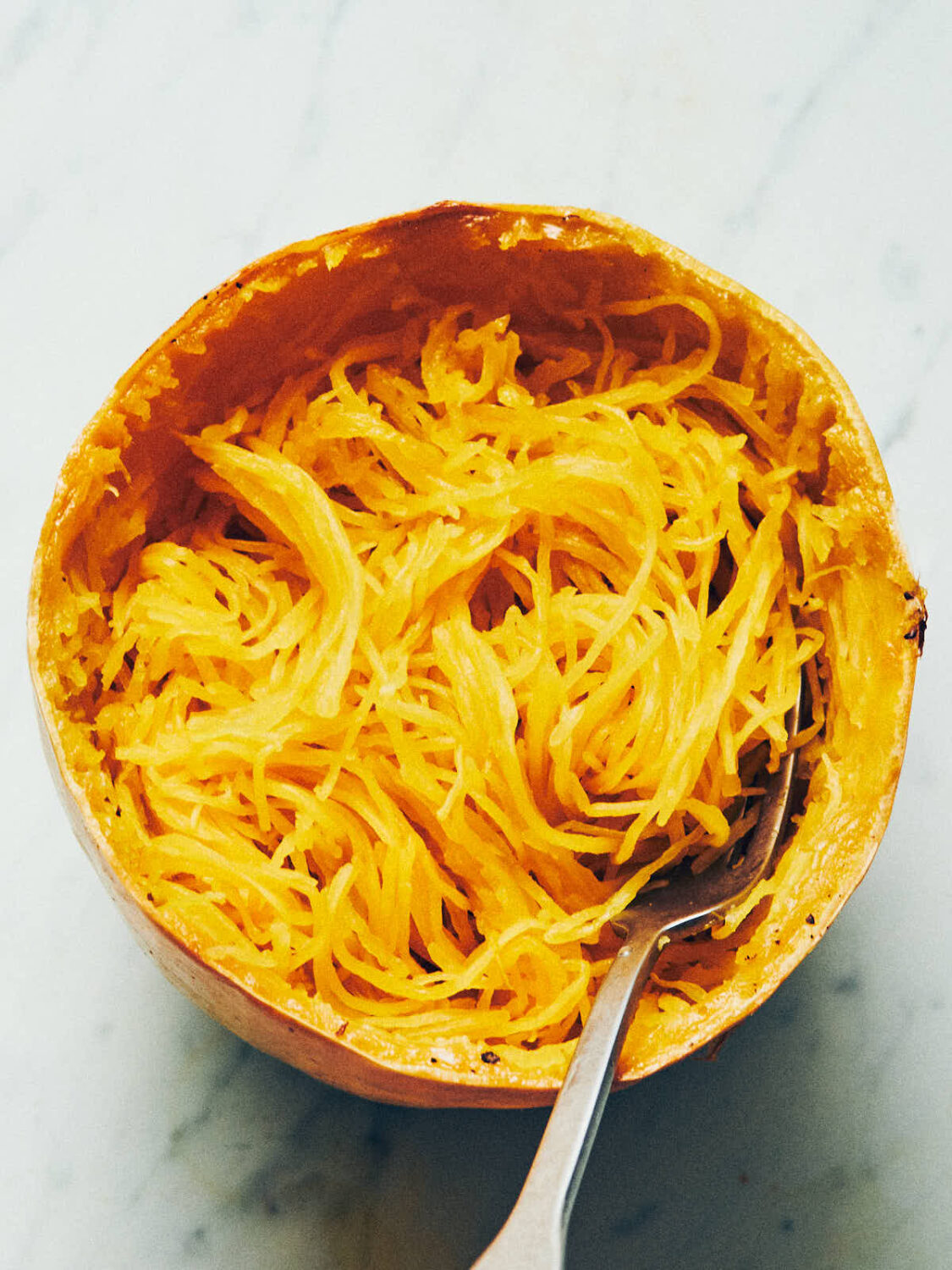
📖 Recipe
How to Cook Spaghetti Squash
Ingredients
- 1 spaghetti squash (about 2½ lbs / 1.1 kg)
- 2 to 3 teaspoons extra virgin olive oil
- Fine sea salt (about ¼ teaspoon)
- Black pepper
Instructions
- Preheat: Preheat oven to 400°F (200°C).
- Prep squash: Cut squash in half crosswise down the middle (not lengthwise, see note 1 and note 2). Use a spoon to scoop out the seeds. Drizzle the cut sides with olive oil, then sprinkle with a bit of salt and pepper. Arrange squash, cut sides down, on a baking sheet.
- Bake: Bake squash until the cut sides are golden and the inside is fork tender (but not soft!), about 40-50 minutes. (Bake time can vary significantly based on the size of the squash, so check a bit earlier to avoid overcooking).
- Cool and fluff noodles: Flip the squash over so the cut sides are facing up, to allow steam to escape. When cool enough to handle, use a fork to gently separate the inside of the squash to form strands. Use as desired or cover and refrigerate.
Notes
- Cutting spaghetti squash: We recommend cutting spaghetti squash crosswise, rather than lengthwise. Cutting the squash crosswise is easier because you only need to make one cut and the resulting noodles are longer. The full post (above) has more details and photos comparing the different methods. But if you need spaghetti squash "boats", go ahead and cut the spaghetti squash lengthwise. In our side by side tests, we found the squash halves cooked at the same rate regardless of which direction they were cut, so simply following the temperature and bake times in the recipe.
- Making spaghetti squash easier to cut (microwave): With the crosswise method, you only need to make one cut down the middle of the squash. Make sure you are using a large, sharp chef's knife on a sturdy surface. If you are struggling to make the cut, then you can soften the squash lightly in the microwave. To microwave the squash: poke holes in the outside of the squash (with the tip of a knife or fork) to allow steam to escape, then microwave for 3 to 5 minutes, and try cutting it again. The microwave will only slightly soften the exterior to the touch, but once you cut through the skin, you'll find the knife cuts more easily through the middle. We don't usually find microwaving necessary, but if you're having trouble, give it a go!
- Storage tips: Spaghetti squash can be refrigerated covered for 4 days. Heat gently before eating, but avoid overcooking.
- Yield: Serves about 2 to 4, depending on the size of the spaghetti squash and the desired use.

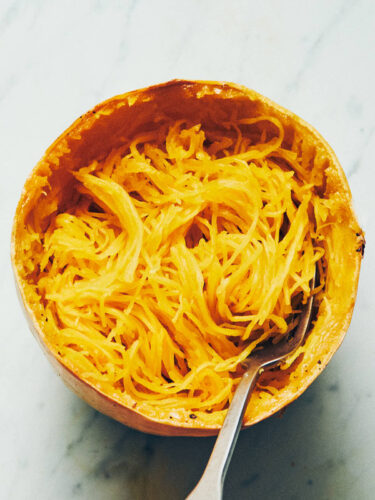
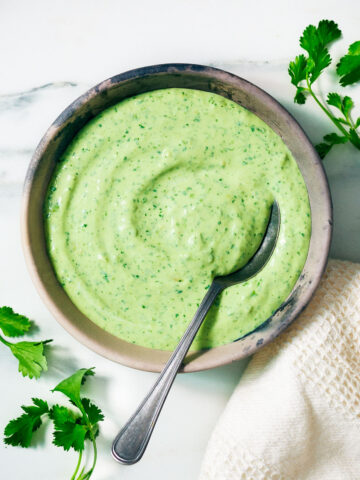


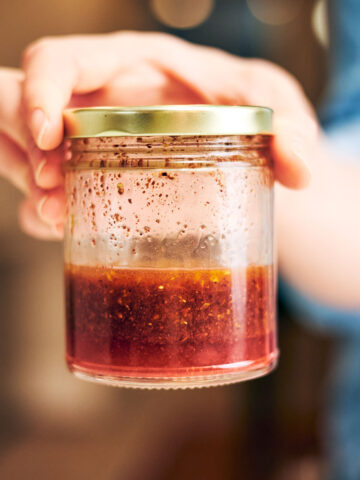
Laurinda says
Thank you for this, I can never remember which is the better way to cut them!
Having the cook time right there makes this the perfect post 💛
bri says
Hi Laurinda! Yay, so glad you found this post helpful:) Thank you so much for taking the time to write in!